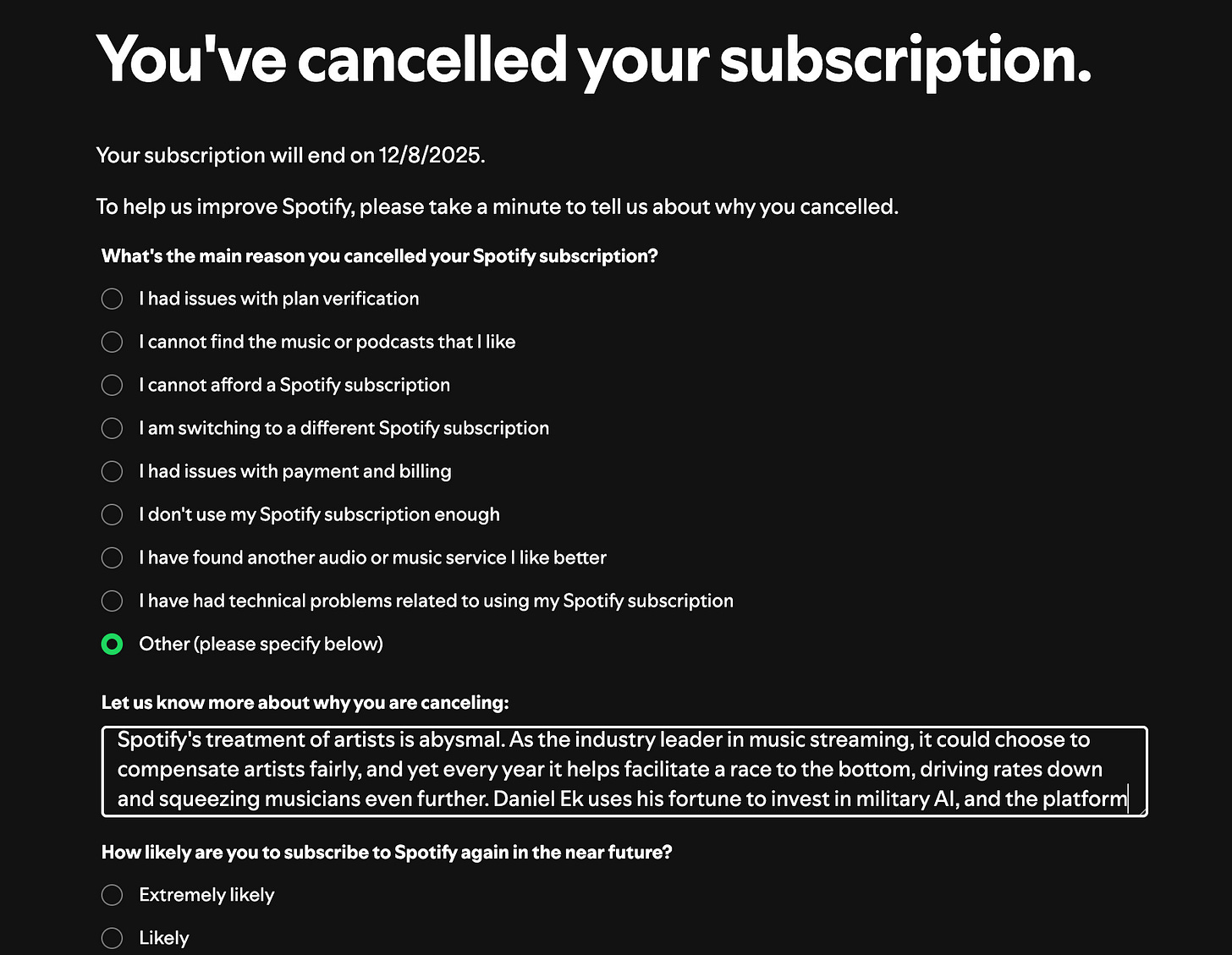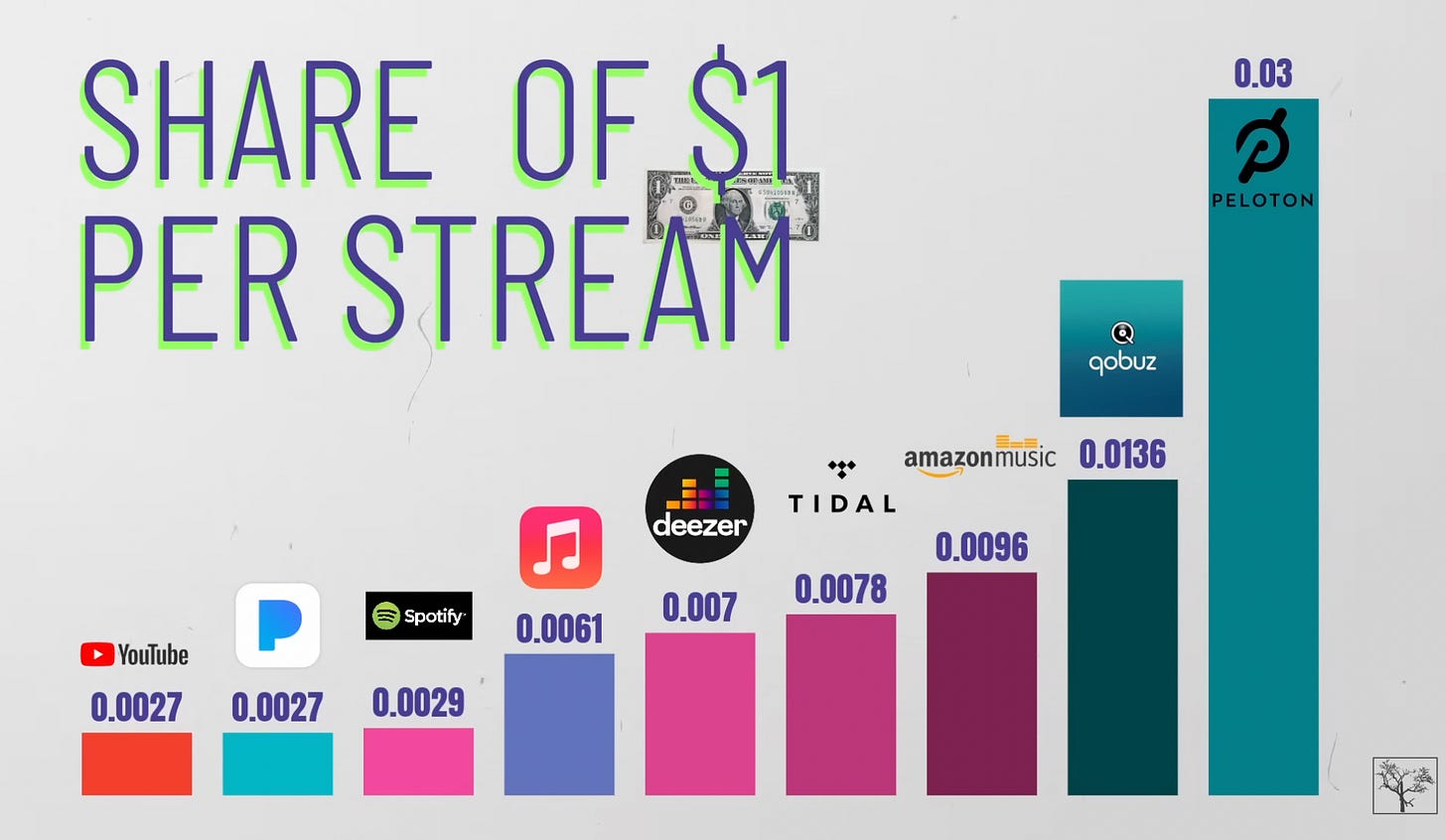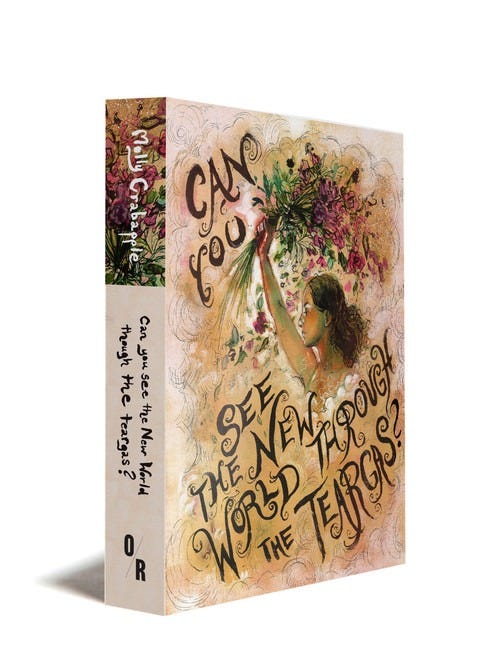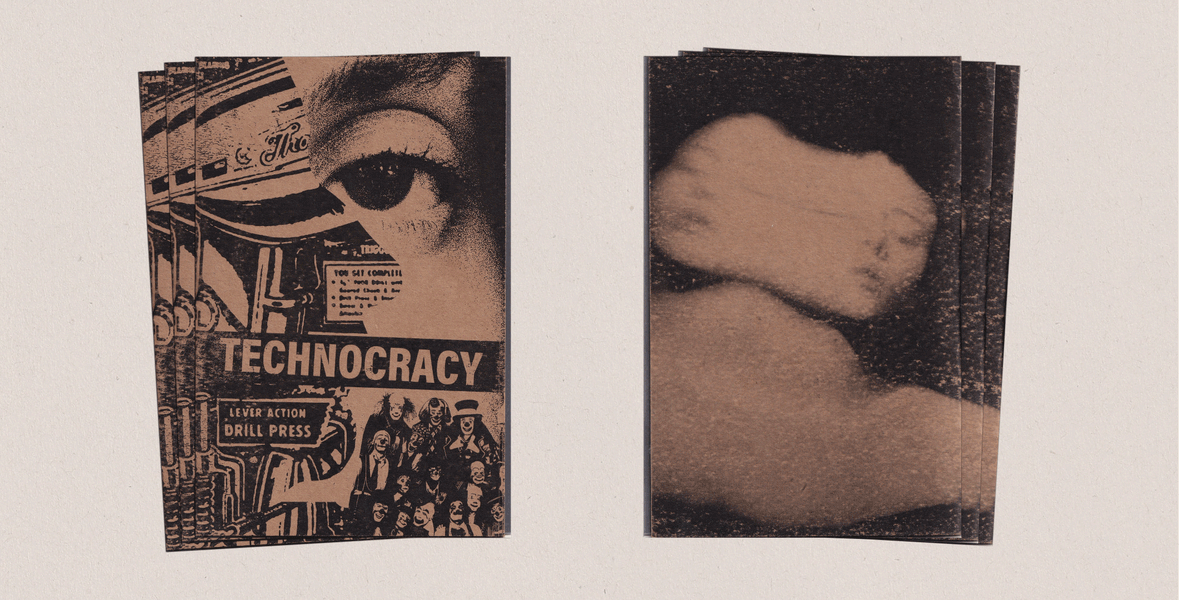How to quit Spotify
This Black Friday, here's a guide to finding the best Spotify alternative
Happy Thanksgiving break to all my friends, comrades, coders, and luddites. Thankful for all of you readers fighting for the user out there. With that, here’s a special Black Friday edition of Blood in the Machine.
I finally cancelled Spotify. I’d been meaning to do this forever, and frankly I’m embarrassed it took me so long. Spotify has been driving down wages for artists far longer than the AI companies, reducing payouts for musicians over the years until most are now making a statistically meaningless amount from the platform; many estimates put the figure as low as $0.003 per stream. In 2024, Spotify stopped paying artists for songs that had fewer than 1,000 streams, despite the fact that 81% of musicians on the platform don’t cross that threshold.
Stories abound of successful artists with millions of monthly listeners can’t afford to take a vacation, a break, or pay rent. The pop star Lily Allen says she makes more money selling pics of her feet on OnlyFans than she does from Spotify royalties. Meanwhile, Spotify just raked in nearly $700 million in quarterly profits. It’s rank exploitation. Don’t take it from me, take it from Bjork. Earlier this year, she succinctly described Spotify as “probably the worst thing that has happened to musicians,” thanks to how the company, and the streaming model it normalized, have so completely corroded artists’ incomes over the last decade or so.
Meanwhile, the company declines to label the AI songs that are overrunning the platform and even boosts them into Discover Weekly playlists, incentivizing their spread. Founder and CEO Daniel Ek used his Spotify fortune to invest in a lethal military tech startup, prompting the most recent round of artist boycotts from the platform. I could go on, but that will probably do—Spotify is everything that’s wrong with Silicon Valley’s engagement with culture and labor condensed into a single platform. Plus, the audio quality sucks.
So why didn’t I go sooner? I justified staying by telling myself I’d use Bandcamp to buy the albums and songs I listened to a lot, which I did, while using Spotify for convenience. That, and the same reasons I still use Gmail: I felt locked in (all those saved songs and playlists) and that the costs of switching would be too high (I would surely lose access to countless songs by switching over). But I am here to tell you today that both of those counts are absolutely false.
I’ve spent the last few days nursing a cold, and figured that I’d use some of that time to test out Spotify alternatives and finally take the plunge. I am extremely glad I did; it’s been a minute since I’ve felt something approaching genuine delight in discovering a new tech service.
So, in time for Black Friday—some of the Spotify alternatives have specials and sales going right now—here’s the Complete BLOOD IN THE MACHINE Guide to Getting Off Spotify.
As always, this work is made possible by the percentage of readers who chip in $6 bucks a month (or $60 a year). It is for you, dear readers, that I spend my sick days listening to new Geese tracks, Prince reissues, and Black Sabbath remasters on various streaming platforms (and not at all for myself), and I very much appreciate your support. If you can afford to, and you find value in this work, please consider joining the ranks of the hammer wielders. Many thanks, and onwards.
A complete guide to quitting Spotify
First, download Bandcamp if you have not done so already. The best way to support artists is to purchase their music directly, and even if the company has been through some rough waters lately, it remains the most convenient way to buy music online and keep it in one place.
Second, I would recommend considering what’s important to you in a streaming platform. Audio quality? Library depth? Fairest payments to artists? Recommendation algorithm? It not being owned by a shithead billionaire or operated by an extractive tech monopoly?
While you’re thinking about that, let’s assuage those two concerns about switching that you likely share with me.
You are not locked into Spotify even a little bit
Your music library is much, much more portable than you think. It will cost you from $0-10 to have a service like Soundiiz automatically transfer your playlists from one service to another. It’s so easy. The platform that I wound up switching to had a deal that let me do this for free. The permissions Soundiiz asked for were not at all onerous, and it took like 5 minutes. Total. I had around 200 playlists, hundreds of albums and artists saved, and several thousand songs and albums favorited. It all ported over seamlessly.
If you’re worried about your meticulously compiled playlists, I would say: Do not at all be. They’ll port over fine. And nearly every single song will still be here, because:
Spotify’s library is not that much better than anyone else’s
This was honestly the biggest surprise. On most streaming services I tried, I found nearly everything I was looking for. That surprise could be due to a long outdated misconception I had, or because AI has fried my brain for the last two years, but I was fully expecting Spotify to at least beat the competition in song selection. But nope, not really. There just wasn’t much deviation, and when I transferred my playlists, I only lost at most a song or two on each. And I listen to some admittedly pretty weird stuff! I did not really expect to find, say, Fluisteraars albums everywhere; either the world has suddenly gotten into Dutch experimental black metal, or it’s simply become easier for artists to upload songs to more platforms.
Okay, so you can transfer streaming libraries nice and easy, and selection isn’t really going to be an issue. Before we break down the alternatives, let’s talk about artist royalties. Most companies publish statements about how they calculate payments, but very few publish the actual rates they pay (there’s one exception, which we’ll get to in a second here), so it’s up to independent auditors to try to track down real numbers. Most streamers also send the payments to the rightsholders, so for musicians on record labels, there are further cuts scooped out.
I found this YouTube segment from the independent musician Benn Jordan really interesting. Since he’s indy, he gets the payments directly, and he put together this breakdown of what the streamers paid him.
Okay, with all that in mind, here’s a dive into the streaming platforms I’ve tried, and my choice of best, most artist-friendly streamer.
Apple Music
Apple Music is the closest thing there is to a straight-up Spotify clone, from my survey, anyway. I used a free trial, and it was fine. Had (nearly) all the music I wanted, audio quality was fine, and the user interface is intuitive. If you use lots of Apple stuff you’ll know what to expect and you probably already have an Apple Music account. I was a little curious to see if the notoriously prude Apple would censor graphic album art like the gory stuff on Cannibal Corpse covers, but I can report here that it did not. Apple pays artists $.006 a stream, which, while quite actually twice as much as Spotify, still kind of sucks. Plus, Apple is Apple, and you’re still handing your music money to a tech giant owned by Tim Cook, who was most recently spotted at the White House’s summit for Saudi Arabia.
Tidal
Tidal was pretty good, actually. Artist pay is $0.008, which is better than Apple, and it seemed to demonstrate a little genuine appreciation of music; there was a contest running on the home page for undiscovered artists when I logged on. The audio quality is noticeably better than Spotify and Apple, and the user interface is OK, even if a little inert. However, Tidal is also the most volatile major music streamer. It has a wacky history; it started in Norway, was bought by Jay Z, who is still a minority stakeholder, and at one point was partially owned by the phone company Sprint. It was eventually bought by Block, formerly Square, the Jack Dorsey-led payment processing company, and laid off 10% of its staff in 2023. The company is apparently currently without a CEO, so it is presumably de facto being led by Dorsey, a man who once said of Elon Musk, “I trust his mission to extend the light of consciousness.” As a result, I do not trust Tidal.
YouTube Music
You have to work pretty hard to be worse than Spotify on all counts. In my admittedly brief tour of YouTube Music, audio quality was bad, it was unappealing to use, and it somehow pays artists even less than Spotify ($0.0027 per stream). Next.
Pandora
I was a little surprised that Pandora, a true mainstay of the 00s’ “music is on the internet” novelty era, was still around. Alas, it also pays artists complete garbage ($0.0027), and since all the major streamers do the vibes-based playlist thing now too, I’m not really sure what Pandora’s value proposition is.
Deezer
The French streamer apparently pays a bit better than the pack ($0.007), and it seemed fine, too, foregrounding its offerings of Pandora-but-pure-mood playlists like ‘Flow’ and ‘Love’. It would be a suitable alternative, perhaps, if it wasn’t for what, in my opinion, is the hands-down best music streamer there is right now.
Qobuz
I spent about 20 minutes on the unfortunately named Qobuz, and I was sold.
First, the artist pay is the best in the biz (except, for some reason, for Peloton’s in-house streaming service). It’s $0.0138, which means it’s more than a penny a stream. Looking at Qobuz’s pay report, Jordan says, “was the first time I looked at streaming royalties and felt fairly compensated.” (The company is also the first to publish its own average payout report, and make its figures public—it cites $0.01873 as its average. A thousand streams means the artist makes ~$19.)
Second, the audio quality is great. I listened to a little bit of everything to test it out, and especially after the flat, compressed sound of Spotify, I didn’t want to stop. It’s got an icon for when albums are available in 24-bit/96 kHz, high resolution format, and it kills. On Qobuz, the Replacements’ Let It Be is raw and crackling, the Flaming Lips’ Soft Bulletin is lush and beautifully layered. Master of Puppets is huge. The (great) new Robyn track Dopamine is crisp and prismatic. Qobuz’s album of the week was a remastered drop of Prince’s Around the World in a Day; it’s majestic. Also that new Geese album everybody likes really is good and sounds great steaming, too.
Third, and the thing that really resonated with me the most, perhaps, was that the people who run Qobuz actually seem to… like music? On the app, along with its Discover and Playlists tab, there’s a Magazine tab with interviews and features. I’m not sure I’ll spend a ton of time reading them, but after years of the algorithmic sludge and pop-up payola recommendations of Spotify, it was refreshing to read thoughtful articles celebrating, say, the post-rock icons Tortoise, Quincy Jones’ catalog, and a Kantō speaker system. I also love how Qobuz lists the record label along with the song title, artist, and its clickable so you can go right to the label to find other bands and so on. There’s *also* no streaming number listed, perhaps because it would be rather low given the relative size of Qobuz’s platform, but I found it refreshing as there is therefore no way to snap-evaluate a song based on its stream count.
This was a nice way to encounter the artists who’ve bailed on Spotify, or, those, like Joanna Newsom, who’ve never relented and let Spotify stream their music in the first place. I bought some of Newsom’s albums on Bandcamp way back when, but I only realized now just how little I’ve listened to them because she wasn’t on Spotify, and how shitty that is. I gave King Gizzard and the Lizard Wizard and Massive Attack a spin, too, since they and dozens others have ditched Spotify over Ek’s investments in Helsing, a German military tech and drone company.
So yeah, I’m having a great time with Qobuz, both because the product is genuinely better than Spotify, and because it feels like sweet release to be free of that shitpit. There are shortcomings, of course—it’s not Siri-compatible, so it won’t work with CarPlay hands-free. It takes longer to load songs and the UI is clumsy on mobile and isn’t as seamless as some other apps. (I also listened mostly on my laptop, as opposed to mobile, and that’s worked great for me.) But those are minor things. More importantly, let’s not have any illusions here: Qobuz, while operated by music biz folks who seem driven (or see an opportunity) to put artists and music at the forefront and de-emphasize the algorithm, is owned by a multimedia conglomerate SA Xandrie, and has completed multiple $10 million plus VC rounds. It’s not some scrappy artists’ collective that can be counted on to keep musicians’ pay decent and AI sidelined. But for now, Qobuzz is great.
And there you have it: An official Blood in the Machine endorsement for ditching Spotify, and trying out a more ethical, better-sounding alternative.
Other BITM-approved gifts for Black Friday and beyond
Friend of the blood, artist, AI critic, and fellow ludd Molly Crabapple has a beautiful new set of illustrated cards out in a set called Can You See The New World Through The Teargas? from OR Books.
The designer Bart Fish has been publishing a great series of strikingly visualized critiques of AI at Power Tools. He’s publishing them as a zine, too; you can order one for a pay-what-you-can donation here. They look amazing:
Finally, the e-reader edition of Blood in the Machine: The Book is, I’m told, on sale at Amazon. Under normal circumstances, that’s not exactly the ideal place to get it, but seeing as how Amazon is certainly taking a loss on the sale here, so by all means, get it for cheap.
OK! That’s it folks. Have a nice holiday weekend, keep that hammer high, and see you all again soon.







Good Job! My husband quit Spotify a few months ago. So proud. Now we need to quit Gmail/Google. If you are able to do it, please write up what you did! I switched to Duck Duck Go for searches but my email and mapping and website are still trapped . Sigh!
Presto music is another streaming service with even better pay per stream.
Per the company: "Since launching our streaming service in 2023, we’ve been stating that the combination of paying rightsholders per second (rather than ‘per play’) AND focussing purely on classical and jazz repertoire means that we’re often paying out up to 10x more than other major streaming services. "
https://www.prestomusic.com/classical/articles/6209--announcement-fair-play-how-much-do-different-streaming-services-pay
https://www.prestomusic.com/about